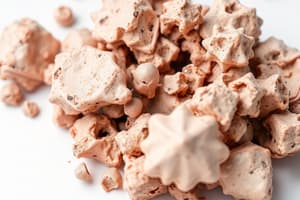Podcast
Questions and Answers
What is a defining characteristic of extensive physical properties?
What is a defining characteristic of extensive physical properties?
- They are observable through sensory perception.
- They remain constant regardless of the amount of substance.
- They can change without altering the substance's composition.
- They depend on the quantity of matter present. (correct)
Which of the following is an example of a physical property of matter?
Which of the following is an example of a physical property of matter?
- The reactivity of sodium
- The acidity of vinegar
- The flammability of gasoline
- The color of a flower (correct)
Which property is NOT considered an intensive physical property?
Which property is NOT considered an intensive physical property?
- Ductility
- Volume (correct)
- Color
- Temperature
Which sense is primarily used to determine the texture of an object?
Which sense is primarily used to determine the texture of an object?
If a substance’s color changes when it is divided, what can be inferred about it?
If a substance’s color changes when it is divided, what can be inferred about it?
What physical property is demonstrated when a material can be stretched into a wire?
What physical property is demonstrated when a material can be stretched into a wire?
Why is the chemical property of reactivity important in daily life?
Why is the chemical property of reactivity important in daily life?
Which of the following demonstrates an intensive physical property?
Which of the following demonstrates an intensive physical property?
Which property describes a trait of matter that does not change regardless of the amount present?
Which property describes a trait of matter that does not change regardless of the amount present?
What type of property is demonstrated when a substance changes its chemical composition during a reaction?
What type of property is demonstrated when a substance changes its chemical composition during a reaction?
Color and taste of a substance are examples of which type of property?
Color and taste of a substance are examples of which type of property?
Which of these materials is likely to be considered a poor conductor of heat?
Which of these materials is likely to be considered a poor conductor of heat?
What is rusting of an iron nail an example of?
What is rusting of an iron nail an example of?
Which property is dependent on the amount of matter present?
Which property is dependent on the amount of matter present?
When a material becomes easily shaped or bent without breaking, it is described as being ____.
When a material becomes easily shaped or bent without breaking, it is described as being ____.
Which characteristic can be perceived with our senses without altering the chemical composition?
Which characteristic can be perceived with our senses without altering the chemical composition?
Which of the following is an example of an extensive physical property?
Which of the following is an example of an extensive physical property?
What process is demonstrated when ink is added to water?
What process is demonstrated when ink is added to water?
Which of the following is NOT an intensive property?
Which of the following is NOT an intensive property?
Which chemical property indicates a substance can catch fire?
Which chemical property indicates a substance can catch fire?
Which application demonstrates malleability in everyday life?
Which application demonstrates malleability in everyday life?
When measuring substances, which of the following tools is best suited for assessing volume?
When measuring substances, which of the following tools is best suited for assessing volume?
Which of the following substances is considered flammable based on the properties described?
Which of the following substances is considered flammable based on the properties described?
What characteristic is associated with the property of rusting?
What characteristic is associated with the property of rusting?
Flashcards are hidden until you start studying
Study Notes
Properties of Matter
- Matter can be classified into two categories: physical properties and chemical properties.
- Physical properties can be observed without changing the chemical composition of the matter.
- Physical properties can be further divided into intensive and extensive properties.
- Intensive Physical Properties are independent of the amount of matter. Examples include:
- Color
- Shape
- Temperature
- Malleability (ability to be hammered into thin sheets)
- Ductility (ability to be stretched into thin wires)
- Diffusion (ability to spread out)
- Extensive Physical Properties are dependent on the amount of matter. Examples include:
- Size
- Mass
- Volume
- Density
- Length
- Width
- Chemical Properties describe how a substance reacts with other substances. Examples include:
- Combustibility (flammability)
- Oxidation (such as rusting)
- Examples:
- Color and taste are intensive physical properties
- Rusting is a chemical property
Measuring Physical Properties
- A measuring tape can be used to measure length, which is an extensive physical property.
- A graduated cylinder can be used to measure volume, which is also an extensive physical property.
Identifying Materials:
- Copper wires are often used for electrical wiring because copper is ductile (can be stretched into wires).
- Materials that easily break when force is applied are brittle.
- Wood is a poor conductor of heat.
Activity 1- Testing the Properties of Matter
- The activity involves observing the physical and chemical properties of: salt, sugar, water, cooking oil, and tissue paper.
- Mass
- Color
- Taste
- Flammability
- The activity aims to help students understand the differences between intensive physical properties, extensive physical properties, and chemical properties.
Studying That Suits You
Use AI to generate personalized quizzes and flashcards to suit your learning preferences.




